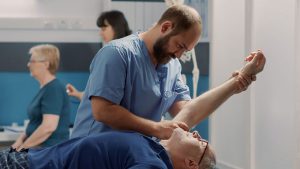It’s all very well singing the benefits of exercise to try to build your muscle, but it’s harder to be enthusiastic when your muscles start aching. Muscle soreness is inevitable, but how does it affect your overall performance, and how can you alleviate its impact?
Muscle soreness can be divided into two different types. Acute muscle soreness (AMS) is the immediate pain during or right after your session (in the first 24 hours). The cause is a buildup of various chemicals and metabolites in the muscles. It’s a burning sort of pain, but it shouldn’t last too long.
Delayed onset muscle soreness (DOMS) tends to peak between the 24 and 72-hour marks but can last for up to a week. It’s a duller ache rather than a sharp pain. One theory is that it’s caused by muscle fibers tearing, then trying to heal. This most often happens when you’re practicing an exercise you haven’t done before or are training with unusually high intensity. Contrary to what some people think, it has nothing to do with lactic acid.
Some soreness when you’ve been working out can be good as it shows you’ve been training well, but it can make doing more exercise, or indeed the activities of daily living, quite uncomfortable. That has led to a lot of debate about the best ways to mitigate both types of muscle soreness to reduce your pain and help you perform better.
Stretching before and after exercise has long been touted as a good way to reduce muscle soreness, but it may not be the most effective solution. Sports massages can increase blood flow, which may relieve some pain and stimulate healing. Heat therapy, such as heat pads, packs, warm towels (preferably damp) or hot baths, can also improve blood flow and is recommended immediately after exercise.
Cold therapy, on the other hand, such as cold packs and ice baths, is best for after heat treatment and aims for more long-term relief by tackling inflammation. Anti-inflammatory supplements or medication are also sometimes recommended, although they have varying levels of evidentiary support.
Of course, you could just reduce incidents of muscle soreness by working your way up to more intense workouts gradually rather than jumping straight into it. Once you’ve been exercising for a while and you’re in better shape, soreness is less likely to be a problem.




